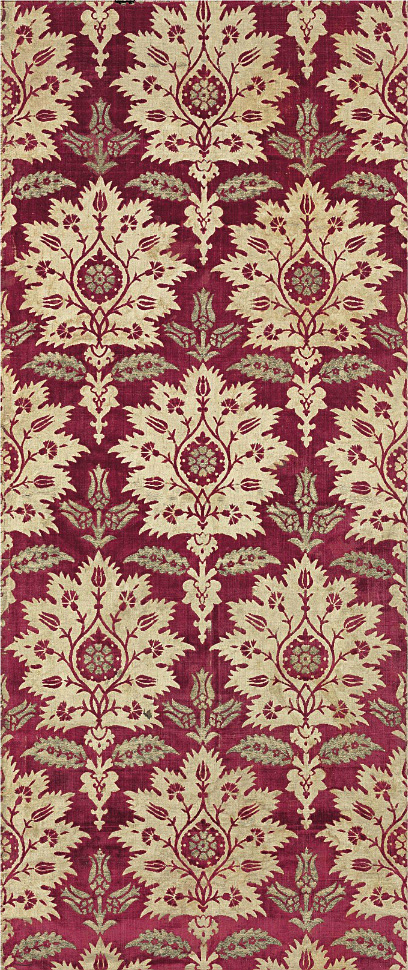|
A SILK AND METAL-THREAD PANEL. BURSA, OTTOMAN TURKEY, 17TH CENTURY
Price Realized £20,000 ($32,320)
Estimate £15,000 - £25,000 ($24,090 - $40,150)
Sale Information
Christies SALE 1557 —
ART OF THE ISLAMIC AND INDIAN
WORLDS
9 October 2014
London, King Street
Lot Description
A SILK AND METAL-THREAD PANEL
BURSA, OTTOMAN TURKEY,
17TH CENTURY
Of rectangular form, the red velvet ground woven with
stepped rows of fleshy palmettes each containing a central flowerhead
framed by alternating carnations and tulips, the palmettes each growing
from a smaller trefoil issuing two saz leaves filled with flowerheads,
between each palmette a spray of three small tulips, whole loom's width,
in gilt frame
59½ x 25¼in. (151 x 64cm.)
Lot Notes
According
to Nurhan Atasoy this design of repeating serrated palmettes, decorated
with a myriad of smaller floral forms, was one of the most popular
categories of design among the velvet weavers of Bursa (Nurhan Atasoy,
Walter B. Denny, Louise W. Mackie and Hülya Tezcan, Ipek, The Crescent and
the Rose, Imperial Ottoman Silks and Velvets, London and Istanbul, 2001,
p.314). Occasionally the motif was confined within an ogival lattice, but
the free-floating format, like ours, seems to have been preferred. A very
similar length, catalogued as first two-thirds of the 17th century is in
the Topkapi Palace Museum (inv.no.13/1444). Another, catalogued as first
half 17th century and woven into a Russian Orthadox dalmatic (sakkos) is
in the Kremlin Armoury Museum in Moscow (inv.no.TK-2293; both published in
Atasoy, Denny, Mackie and Tezan, op.cit., nos.338 and 341, pp.415-15). A
yastik of similar design, catalogued as circa 1600, is in the Metropolitan
Museum of Art (Maryam D. Ekhtiar, Priscilla P. Soucek, Sheila R. Canby and
Navina Najat Haidar, Masterpieces from the Department of Islamic Art in
the Metropolitan Museum of Art, New York, 2011, no.213, p.325). |

